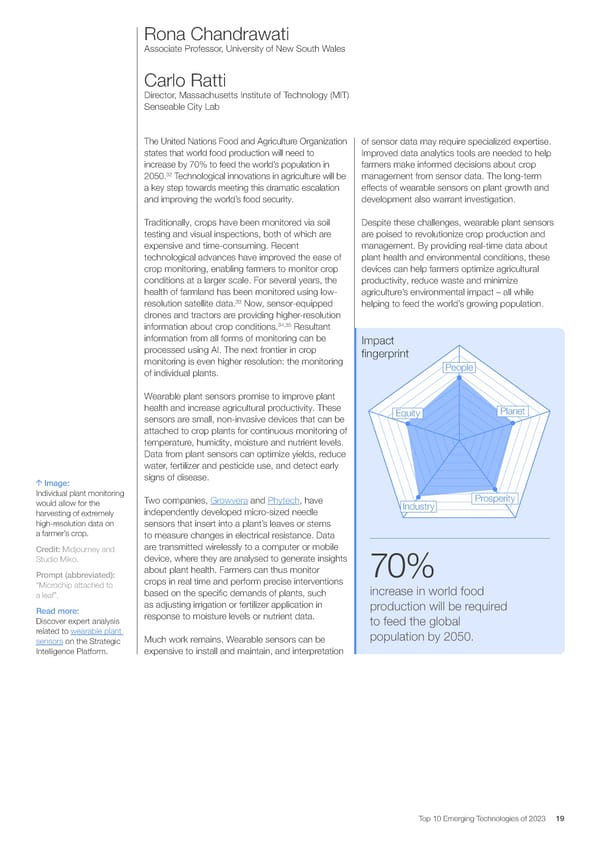Rona Chandrawati Associate Professor, University of New South Wales Carlo Ratti Director, Massachusetts Institute of Technology (MIT) Senseable City Lab The United Nations Food and Agriculture Organization of sensor data may require specialized expertise. states that world food production will need to Improved data analytics tools are needed to help increase by 70% to feed the world’s population in farmers make informed decisions about crop 32 2050. Technological innovations in agriculture will be management from sensor data. The long-term a key step towards meeting this dramatic escalation effects of wearable sensors on plant growth and and improving the world’s food security. development also warrant investigation. Traditionally, crops have been monitored via soil Despite these challenges, wearable plant sensors testing and visual inspections, both of which are are poised to revolutionize crop production and expensive and time-consuming. Recent management. By providing real-time data about technological advances have improved the ease of plant health and environmental conditions, these crop monitoring, enabling farmers to monitor crop devices can help farmers optimize agricultural conditions at a larger scale. For several years, the productivity, reduce waste and minimize health of farmland has been monitored using low- agriculture’s environmental impact – all while resolution satellite data.33 Now, sensor-equipped helping to feed the world’s growing population. drones and tractors are providing higher-resolution 34,35 Resultant information about crop conditions. information from all forms of monitoring can be Impact processed using AI. The next frontier in crop 昀椀ngerprint monitoring is even higher resolution: the monitoring People of individual plants. Wearable plant sensors promise to improve plant health and increase agricultural productivity. These Equity Planet sensors are small, non-invasive devices that can be attached to crop plants for continuous monitoring of temperature, humidity, moisture and nutrient levels. Data from plant sensors can optimize yields, reduce water, fertilizer and pesticide use, and detect early Image: signs of disease. Individual plant monitoring Two companies, Growvera and Phytech, have Prosperity would allow for the Industry harvesting of extremely independently developed micro-sized needle high-resolution data on sensors that insert into a plant’s leaves or stems a farmer’s crop. to measure changes in electrical resistance. Data Credit: Midjourney and are transmitted wirelessly to a computer or mobile Studio Miko. device, where they are analysed to generate insights Prompt (abbreviated): about plant health. Farmers can thus monitor 70% “Microchip attached to crops in real time and perform precise interventions increase in world food a leaf”. based on the speci昀椀c demands of plants, such Read more: as adjusting irrigation or fertilizer application in production will be required Discover expert analysis response to moisture levels or nutrient data. to feed the global related to wearable plant population by 2050. sensors on the Strategic Much work remains. Wearable sensors can be Intelligence Platform. expensive to install and maintain, and interpretation Top 10 Emerging Technologies of 2023 19
 Top 10 Emerging Technologies of 2023 Page 18 Page 20
Top 10 Emerging Technologies of 2023 Page 18 Page 20